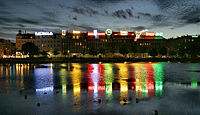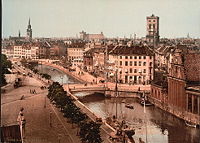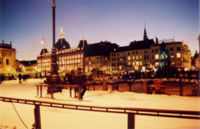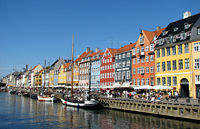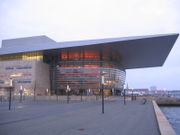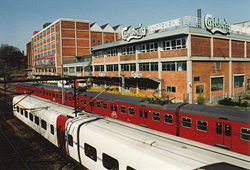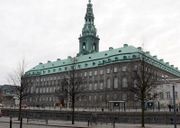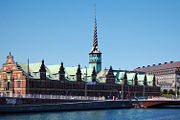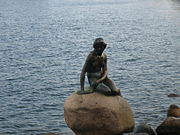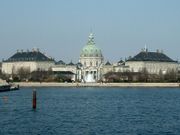Copenhagen
2008/9 Schools Wikipedia Selection. Related subjects: Europe; European Cities
 |
|
| City coat of arms | |
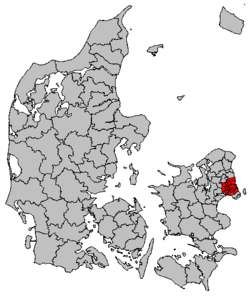
|
|
| Area | |
|---|---|
| - Municipal | 88.25 km² |
| - Capital region | 2673 km² |
| Population (2008-01-01) | |
| - Municipal | 503,861 |
| - City | 1,145,804 |
| - Metropolitan Area | 1,835,467 |
| - Density (city/met/region/region+) | 5777/1947/812/686/km² |
| Additional information | |
| Time zone | Central European: UTC+1 |
| Latitude Longitude |
55°43' N 12°34' E |
Copenhagen (IPA: /ˌkəʊpənˈheɪgən, ˌkəʊpənˈhɑːgən, ˈkəʊpənˌheɪgən, ˈkəʊpənˌhɑːgən/; Danish: København ( help· info) IPA: [kʰøb̥ənˈhɑʊ̯ˀn, kʰøb̥m̩ˈhɑʊ̯ˀn]) is the capital and largest city of Denmark. It is situated on the Zealand and Amager Islands and is separated from Malmö, Sweden by the strait of Øresund.
With the completion of the transnational Oresund Bridge in 2000, Copenhagen and the Swedish city of Malmö are connected by a car/rail link and are in the process of integrating their labour markets, resulting in the number of commuters from both sides growing annually.
In 2008, the magazine Monocle listed Copenhagen first in their Top 20 Most Livable Cities Chart. In addition, it has also been classified as a GaWC Cultural World City, while it is 3rd in Western Europe in the rivalry over regional headquarters and distribution centers, only surpassed by London and Paris.
The original designation for the city, from which the contemporary Danish name is derived, was Køpmannæhafn, "merchants' harbour". The English name for the city is derived from its Low German name, Kopenhagen. The element hafnium is named after the city's Latin name, Hafnia.
Copenhagen municipalities
The conurbation of Copenhagen consists of several municipalities. The central and largest is Copenhagen municipality, the second largest is Frederiksberg municipality which is an enclave inside Copenhagen municipality. Both are contained in the larger Copenhagen Capital Region, which contains most of the Copenhagen metropolitan area.
Previously, the areas of Frederiksberg, Gentofte and Copenhagen municipalities have been used to define the city of Copenhagen. This definition is now obsolete. To meet statistical needs after the latest municipal reform, which took place in the beginning of 2007, an effort has been made to work out definitions of lands (landsdele) in Denmark. A land is basically a geographical and statistical definition, and the area is not considered to be an administrative unit. The land of Copenhagen City includes the municipalities of Copenhagen, Dragør, Frederiksberg and Tårnby, with a total population of 656,582 in the beginning of 2008.
Copenhagen and Frederiksberg were two of the three last Danish municipalities not belonging to a county. On 1 January 2007, the municipalities lost their county privileges and became part of Copenhagen Capital Region.
History
From the Viking Age there was a fishing village by the name of "Havn" (harbour) at the site. From the middle of the 12th century it grew in importance after coming into the possession of the Bishop Absalon, who fortified it in 1167, the year traditionally marking the foundation of Copenhagen. The excellent harbour encouraged Copenhagen's growth until it became an important centre of commerce (hence its name - the first part of the word denoting commerce in Danish language). It was repeatedly attacked by the Hanseatic League as the Germans took notice. In 1254, it received its charter as a city under Bishop Jakob Erlandsen.
During 1658-59 it withstood a severe siege by the Swedes under Charles X and successfully repelled a major assault. In 1801 a British fleet under Admiral Parker fought a major battle, the Battle of Copenhagen, with the Danish navy in Copenhagen harbour. It was during this battle Lord Nelson famously "put the telescope to the blind eye" in order not to see Admiral Parker's signal to cease fire. When a British expeditionary force bombarded Copenhagen in 1807, to gain control of the Danish navy, the city suffered great damage and hundreds of people were killed. The reason why the devastation was so great was that Copenhagen relied on an old defence-line rendered virtually useless by the increase in shooting range available to the British. But not until the 1850s were the ramparts of the city opened to allow new housing to be built around the lakes ("Søerne") which bordered the old defence system to the west. This dramatic increase of space was long overdue, not only because the old ramparts were out of date as a defence system, but also because of bad sanitation in the old city. Before the opening, Copenhagen Centre was inhabited by approximately 125,000 people, peaking in the census of 1870 (140,000); today the figure is around 25,000. In 1901, Copenhagen expanded further, incorporating communities with 40,000 people, and in the process making Frederiksberg an enclave within Copenhagen.
During World War II, Copenhagen was occupied by German troops along with the rest of the country from 9 April 1940 until 4 May 1945. In August 1943, when the government's collaboration with the occupation forces collapsed, several ships were sunk in Copenhagen Harbour by the Royal Danish Navy to prevent them being used by the Germans. The city has grown greatly since the war, in the seventies using the so-called five-finger-plan of commuter trainlines to surrounding towns and suburbs.
Since the summer 2000, the cities of Copenhagen and Malmö have been connected by a toll bridge/tunnel ( Øresund Bridge), which allows both rail and road passengers to cross. As a result, Copenhagen has become the centre of a larger metropolitan area which spans both nations. The construction of the bridge has led to a large number of changes to the public transportation system and the extensive redevelopment of Amager, south of the main city.
Copenhagen in the future
Copenhagen is known as a low-rise city with its old beautiful buildings. But this is going to change. Many modern buildings will be built in the coming years. Some examples:
The Marble Pier The upcoming high-rise area in Copenhagen, The Marble Pier, where UN headquarters in Denmark, hotel, offices etc. will be placed. Tallest building 144 m.
Our City Carlsberg's upcoming building project. Expected to start in 2010 and end in 2029, with an estimated cost of over 2,8 billion Euro.
DI new HQ DI ( Dansk Industri) will in 2009/2010 restore and modernise their current HQ. The building will give Rådhuspladsen a more modern and futuristic look.
Copenhagen Towers Crowne Plaza/Office Towers. Expected to complete in 2009. Just in time for the global climate conference held by UN
Ørestad Business Centre
Bella Centre Hotel
Fields Tårn
Location
Copenhagen is located on the eastern shore of the island of Zealand (Sjælland) and partly on the island of Amager. Copenhagen faces the Øresund to the east, the strait of water that separates Denmark from Sweden, and that connects the North Sea with the Baltic Sea. On the Swedish side of the sound directly across from Copenhagen, lie the towns of Malmö and Landskrona.
Copenhagen is also a part of the Øresund region, which consists of the eastern part of Zealand in Denmark and the western part of Scania in Sweden.
Boroughs and Areas
Copenhagen consists of a number of boroughs and areas, including
- Indre By
- Østerbro
- Nørrebro
- Vesterbro
- Amagerbro
- Nordhavnen (North Habour)
- Valby
- Kongens Enghave (King's Meadow Garden), also known as Sydhavnen (meaning South Harbour)
- Christianshavn
- Christiania (Freetown)
- Sundbyvester (Sundby West),
- Sundbyøster (Sundby East)
- Ørestad
- Islands Brygge
- Bellahøj
- Brønshøj
- Ryparken
- Bispebjerg
- Vigerslev
- Vestamager
- Vanløse
The term bro in the names Østerbro, Nørrebro, and Vesterbro should not be confused with the Danish word for bridge, which is also 'bro'. The term is thought to be an abbreviation or short form of the Danish word brolagt meaning paved referring to the roads paved with cobblestones leading to the city's former gates - Østerport, Nørreport, and Vesterport - around which these boroughs grew. Thus the names could roughly be translated as Eastern, Northern, and Western Paved (Road), respectively.
Today the names Østerport, Nørreport, and Vesterport all refer to train stations located on the railroad that was built where the city-walls used to be. This is the border between the medieval town and the rest of Indre By.
Outer suburbs
Transport Mostly all of Copenhagen's suburbs are linked to central Copenhagen by highways. Lately many of these highways have been widened with 2 or 3 lanes, beacause of the heavily increasing rush-hour traffic. The S-Train also connects almost all the suburbs of Copenhagen. There have been suggestions of a new plan for a tram line running from the northern to the southern suburbs. Ideas that some of the new Metro lines should be running to some of the inner-suburbs, have been suggested as well. Mainly those which are not connected by S-Train.
Northern suburbs
- Lyngby
- Klampenborg
- Hørsholm
- Søllerød
- Brede
- Gentofte
- Charlottenlund
- Virum
- Sorgenfri
- Nærum
- Vedbæk
- Tårbæk
- Skodsborg
- Holte
- Birkerød
Some of these suburbs are spoken of as "The Whiskey Belt" because most families have a high income. Especially along the Strandvejen (Beach Road), where mostly owners of private enterprises live. Approx. 200,000 people live in the northern suburbs.
North-Western suburbs
- Værløse
- Farum
- Bagsværd
- Buddinge
- Tingbjerg
- Mørkhøj
- Søborg
- Vangede
- Gladsaxe
- Høje-Gladsaxe (Gladsaxe Heights)
- Hareskovby
These suburbs are mostly middle-class suburban. Mostly covered by single-family houses and in some areas housing projects. These suburbs are typically sleepy-towns with not much cultural life and mostly all shops closing at 6pm. Some of the areas have 65% or more percent of immigrants, while other areas, only have 5-6% immigrants or people with foreign-background. Approx. the north-western suburbs has 98,000 inhabitants
Western suburbs
- Herlev
- Ballerup
- Skovlunde
- Smørum
- Islev
- Måløv
- Rødovre
- Glostrup
- Brøndby
- Hvessinge
- Albertslund
- Taastrup
- Høje-Taastrup (Taastrup Heights)
- Hedehusene
Most of these suburbs have many industrial zones and low income shops along the main roads, especially along Roskildevej. The suburbs' inhabitants live in either single-family houses and high-rise housing projects as in Brøndby and in Rødovre which also houses a high number of immigrants. In Albertslund you find Denmark's largest concrete low-rise housing project. Approx. 294,000 people live in the westerne suburbs.
South-Western suburbs
- Avedøre
- Friheden
- Hvidovre
- Åmarken
- Brøndby Strand
- Vallensbæk
- Ishøj
- Hundige
- Greve
- Karlslunde
- Solrød
- Jersie
- Køge
The suburbs closest to Copenhagen City are dominated by large housing projects/concrete suburb. This is mostly middle and low-income areas. The more distant suburbs consist mainly of single-family houses. The south-western suburbs of Copenhagen have a sizeable number of first and second generation immigrants. The south-western suburbs have approximately 200,000 inhabitants.
Amager Island suburbs
- Kastrup
- Tårnby
- Dragør
The coastal town Dragør can be counted as a suburb because of the short distance to Copenhagen. But most people living in Dragør feel that they are distant or disconnected from the people of Copenhagen because of a difference in lifestyles. Dragør also has a lot of old houses, that makes Dragør look like a village town. Kastrup is the most "visited" suburb of Copenhagen simply because The Copenhagen Airport resides here, most of the houses in Kastrup are primarily single-family houses and low-rise. Tårnby has one small housing project, and in the southern part of the suburb, roads are named after African countries. Only about 53,000 people live in the Amager suburbs (suburbs: South-East).
Population
Since the exact city-limits of Copenhagen are poorly defined, the population numbers are somewhat abstract. Statistics Denmark uses a measure of the contiguously built-up urban area of Copenhagen, this means the number of communities included in this statistical abstract has changed several times, in the abstracts latest edition with slightly more than 1.1 million (1,145,804 (2007)) inhabitants. This number is not af strict result of the commonly-used measuring methods of 200 meters of continuously build-up area, as there are exceptions to the general rule in the suburbs of Dragør, Taastrup, Birkerød, Hørsholm and Farum. Statistics Denmark has never stated the geographical area of urban Copenhagen. However we know it consists of Copenhagen Municipality, Frederiksberg and 16 of the 20 municipalities in the old counties Copenhagen and Roskilde, though 5 of them only partially.
Statistics Denmark has worked out definitions of so-called lands (landsdele), a definition used to meet statistical needs on a lower level than regions. From this, the land of Copenhagen city (København by) is defined by the municipalities of Copenhagen, Dragør, Frederiksberg and Tårnby, with a total population of 656,582 in the beginning of 2008. The surroundings of Copenhagen is defined by another land, Copenhagen suburban (Københavns omegn), which includes the municipalities of Albertslund, Ballerup, Brøndby, Gentofte, Gladsaxe, Glostrup, Herlev, Hvidovre, Høje-Taastrup, Ishøj, Lyngby-Taarbæk, Rødovre and Vallensbæk, and with a total population of 504,481 (January 1 2008). This gives a total population of 1,161,063 for these two lands together. The lands of Copenhagen city and Copenhagen suburban can together be used as a definition of the metropolitan area, although perhaps a somewhat narrow one.
From 1 January 2008 the population of the 33 municipalities closest to and including the municipality of Copenhagen is 1,835,371. Land area: 2,673 km² (1,032 sq mi). (Copenhagen Region - Bornholm + East Zealand). Water area: 105 km² (40.5 sq mi). Thus, the region comprises 6.3% of the land area of Denmark, but has 33.5% of Denmark's population. This gives a total of 686 inhabitants per km² or 1,776 per square mile for the region. This compares with a population density in the rest of the country of approximately 90 per km² or around 230 per square mile.
A high-ranking civil servant of the Interior Ministry, Henning Strøm, who was involved in (i.e. known as "the Father of") a past municipal reform, which took effect on 1 April 1970, said on television, broadcast in connection with the recent Kommunalreformen ("The Municipal Reform" of 2007), that Copenhagen municipality would encompass an area with 1.5 million inhabitants, if the principles of the 1970 municipal reform were also applied on Copenhagen municipality. In other words: in the rest of Denmark the city occupies only part of the municipality, but in Copenhagen the municipality of Copenhagen occupies only part of the city of Copenhagen.
Recreation and Culture
Music and entertainment
The Copenhagen Jazz Festival, which takes place in summer, is a popular annual event that is the result of a significant jazz scene having existed for many years. It developed when a number of American jazz musicians such as Ben Webster, Thad Jones, Richard Boone, Ernie Wilkins, Kenny Drew, Ed Thigpen, Bob Rockwell and others such as rock guitarist Link Wray came to live in Copenhagen during the 1960s.
Recently, the Hafnia Chamber Orchestra has been added to the cultural platform of Copenhagen. Established by the talented conductor Simon Casali-Krzentowski in 2001, the Hafnia Chamber Orchestra strives to bring Danish composers to a wider audience.
For free entertainment one can stroll along Strøget, especially between Nytorv and Højbro Plads, which in the late afternoon and evening is a bit like an impromptu three-ring circus with musicians, magicians, jugglers and other street performers.
Sports
Copenhagen has a wide variety of sport teams. The football team, FC København, are based in Copenhagen. FC København plays at Parken in Østerbro, Copenhagen. Notable Copenhagen teams playing at the second highest level in Danish football (the Danish 1st Division) include AB, HIK, Frem, Brønshøj, Fremad Amager and Skjold.
Copenhagen also has three ice hockey teams: Rødovre Mighty Bulls, Herlev Hornets and Nordsjælland Cobras.
There are a lot of handball teams in Copenhagen. FC København owns both a women's and a men's team, which have the same name and logo. They were formerly known as FIF. Of other clubs playing in the "highest" leagues there are; Ajax Heroes, Ydun, and HIK ( Hellerup).
Rugby union is also played in the Danish capital with teams such as CSR-Nanok, Copenhagen Scrum, Exiles, Froggies and Rugbyklubben Speed.
The Danish Australian Football League, based in Copenhagen is the largest Australian rules football competition outside of the English speaking world.
Copenhagen is also home to a number of Denmark's 40-odd cricket clubs. Although Denmark has been an associate member of the International Cricket Council since 1966, the sport is not taught much in schools, and Danish cricket competes unfavourably with the much more widely followed sport of football for players, facilities, media attention and spectators.
Copenhagen is also home to three prominent paintball teams, the Copenhagen Ducks, The Ugly Ducklings and the Copenhagen Berserks. Because of paintball's relative popularity in Scandinavia, these teams are well-known throughout the globe, despite Denmark's small size.
The second World Outgames will take place in Copenhagen in 2009, after Berlin refused to stage them due to the continuing rivalry between the two gay sporting organisations.
Cuisine
Copenhagen offers a great variety of fine restaurants and it is possible to find modest eateries with open sandwiches (called " smørrebrød"), which is the traditional and best known dish. Most restaurants, though, serve international dishes.
The city boasts an impressive 11 Michelin star restaurants. Restaurant Noma (Nordisk Madhus) has currently been voted the 10th best restaurant in the world, and recently it received another Michelin star in addition with the one it already had received.
Since the nineteen-eighties, immigration from the Pakistan, Middle East, Turkey and Arabian countries has introduced fast food dishes such as kebab and falafel, which have become as popular as more traditional Danish fast food.
Nature
Copenhagen and the surrounding counties have 3 beaches with a total of approx. 8km of sandy beaches within 30 minutes bicycling from the city centre. This includes Amager Strandpark, a 2 km long artificial island which opened in 2005 and is located just 15 minutes by bicycle from the city centre.
Economy
Copenhagen is a centre for business and science, not only in Denmark, but also in the Oresund Region and Scandinavia. Thus the Copenhagen Capital Region had both the highest GDP per capita and economic growth in the whole of Denmark in 2005. In a 2006 survey of the richest cities in the world, Copenhagen was ranked 9th, and along with the Norwegian capital Oslo the highest gross wages were paid in Copenhagen, but the high taxes mean that wages are reduced after mandatory deduction. Furthermore, Copenhagen has in several surveys been ranked as one of the most expensive cities in the World. In a newly released survey by the Swiss bank UBS AG, the second largest bank in Europe by market capitalisation, Copenhagen had the highest gross wages in the World, and the average wage earner in Copenhagen earned somewhat 40% more than the average person in New York, considering the 14 most prevalent crafts , but when considering the tax level and generel prices, Copenhagen drops down to a 6th place in the survey and in a calculation of the hourly domestic puchasing power, with the most common average expenses and rent included, Copenhagen only reaches a 16th place, behind cities such as Zurich, Munich and Oslo.
Several international companies have established their regional headquarters in Copenhagen, e.g. Microsoft. Maersk, the world's largest container shipping company, has their world headquarters in Copenhagen. A substantial number of Danish pharmaceuticals such as Novo Nordisk, Ferring Pharmaceuticals and Bavarian Nordic also operate in the area, having placed their headquarters in or close to Copenhagen.
Science, Research and Education
Copenhagen is home to the oldest and largest university in Denmark, the University of Copenhagen founded in 1479. The University does renowned research within science, health, law, social sciences, theology and the humanities and forms part of the International Alliance of Research Universities (IARU), which is a collaboration between high-ranking universities including Oxford, Cambridge, Yale and the University of California at Berkeley. The University attracts app. 1500 international and exchange students every year. The city is also home to EQUIS accredited and high-ranked Copenhagen Business School.
Transport
The greater Copenhagen has a very well established transportation infrastructure making it a hub in Northern Europe. By a quality service of roads, railways, airports and harbours has earned Denmark a top ranking in the IMD’s World Competitiveness Yearbook and in the World Economic Forum’s Global Competitiveness Report for several consecutive years
Roads
Copenhagen has a large network of toll-free highways and public roads connecting different municipalities of the city together and to Northern Europe . As in many other cities in Europe traffic is increasing in Copenhagen. The radial arterial roads and highways leading to the Copenhagen city centre are critical congested during peak hours .
Cycling
The city's bicycle paths are extensive and well-used. Bicycle paths are often separated from the main traffic lanes and sometimes have their own signal systems. Copenhagen is known as one of the most bicycle-friendly cities in the world, with up to 32% of people commuting to work by bicycle and is a centre of bicycle culture. The city provides public bicycles which can be found throughout the downtown area and used with a returnable deposit of 20 kroner.
Copenhagen's well-developed bicycle culture has given rise to the term ' copenhagenize'. This is the practice of other cities adopting Copenhagen-style bike lanes and bicycle infrastructure.
Harbour
The harbour of Copenhagen, since 2001 merged with Malmö to Copenhagen-Malmö Port, has several functions but its main function today is a major cruise destination.
Cruise Copenhagen Network was established in 1992 as a partnership between the Port of Copenhagen, the City of Copenhagen and 45 professional suppliers, in order to strengthen and develop Copenhagen as the most successful home port for cruises in Scandinavia and the Baltic Sea. The trade magazine Dream World Cruise Destinations recently polled the cruise lines, who voted Copenhagen no. 1 in several categories: Most Responsive Port and Best Destination Experience for Independent Sightseeing. World Travel Awards has several years in a row awarded Copenhagen Port as the number one cruise destination in Europe as well as the best port in the world.
Airports
Copenhagen has two airports, Kastrup (the large international airport) and Roskilde Lufthavn (a smaller international and general aviation airport). Kastrup, also known as Copenhagen Airport, is Europe's 17th busiest airport and has four times won the award as being "The best airport in Europe", and two times as "The best airport in the world".
Public transportation
The public transportation system of Copenhagen consists of commuter trains (called " S-trains" (S-tog)), buses, and a metro. The S-trains form the basis of the transportation network, stretching to most areas of metropolitan Copenhagen, with their main hub at Copenhagen Central Station (København H). Regional trains supplement the S-train services with lines extending further such as to the Copenhagen Airport, Elsinore, and Malmö. The Danish State Railways' Intercity network has its eastern terminus and main hub at Copenhagen, with most trains extending to Copenhagen Airport.
The fare system is based on 95 zones covering the capital area. Tickets are transferable from one means of transport to another within a time limit. The more zones a ticket is valid for, the longer its time validity with a maximum of two hours. Discount cards (punch cards, klippekort) and period cards are available. Ticket prices are high and have increased substantially in recent years leading to a decrease in passenger numbers. In fact, the percentage of trips made on public transportation in Copenhagen is quite low by northern European standards.
Places of note in or near Copenhagen
- Amalienborg Palace
- Assistens Cemetery (Assistens Kirkegård)
- Arken Museum of Modern Art
- Børsen, the former Stock Exchange
- Church of Holmen
- Copenhagen Opera House
- Danish Design Centre
- Bakken
- Christiansborg
- Copenhagen Zoo
- Danish National Gallery
- Danmarks Nationalbank
- Frederiksborg Palace in Hillerød
- Freetown Christiania
- Gefion fountain
- Kastellet
- Kronborg Castle — Hamlet's castle in Elsinore (Helsingør)
- The Little Mermaid
- Louisiana Museum of Modern Art
- National Museum of Denmark
- Ny Carlsberg Glyptotek
- Nyhavn
- Rosenborg Castle
- Roskilde
- Rundetårn
- Strøget
- Tivoli Gardens (amusement park)
- University of Copenhagen
- Ungdomshuset (demolished)
Notable natives
|
|
